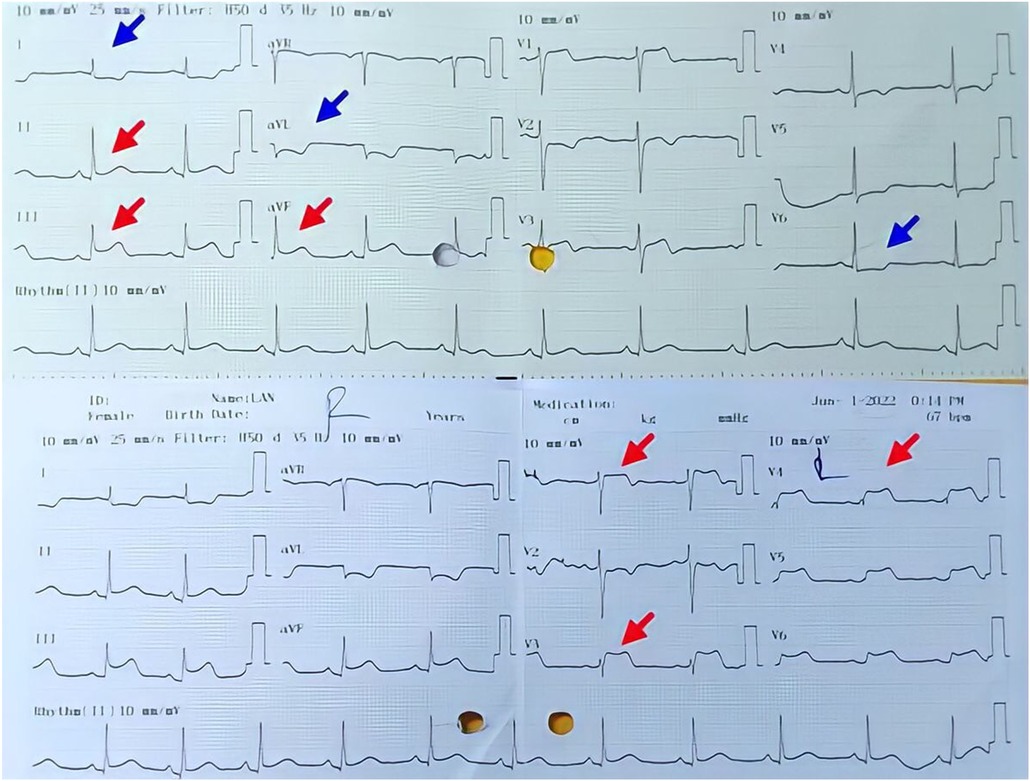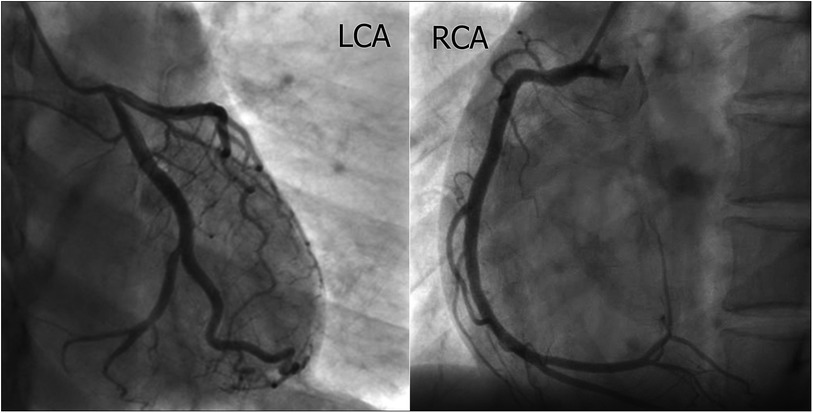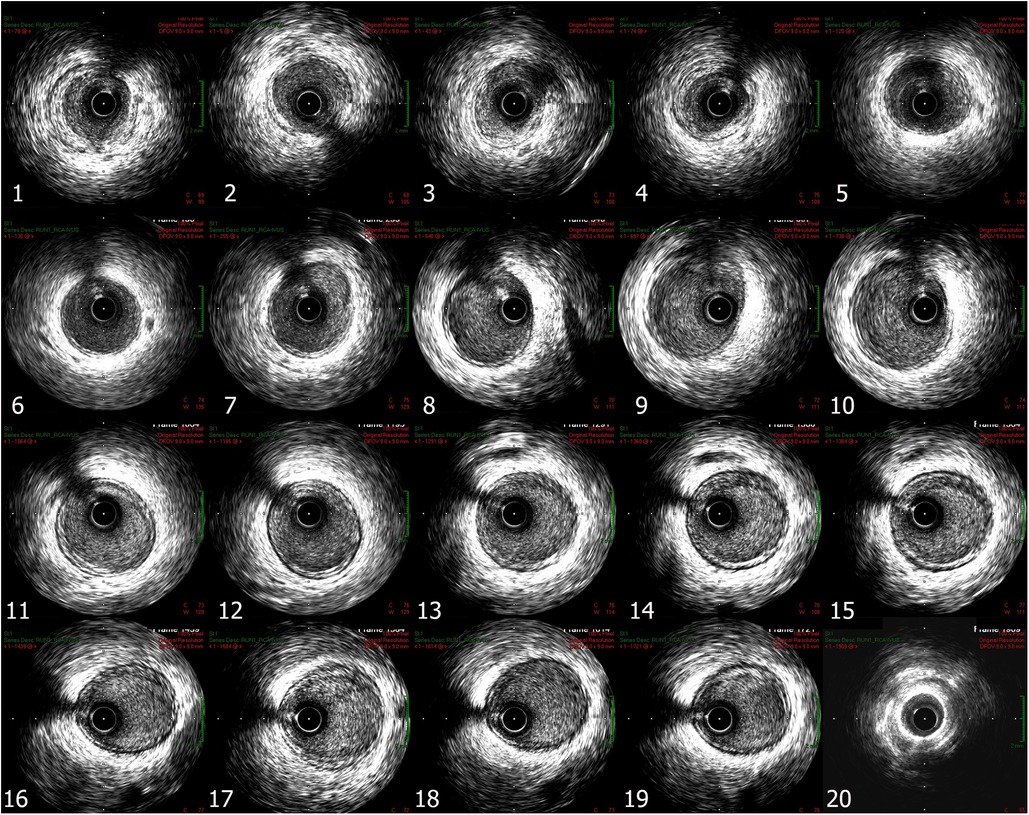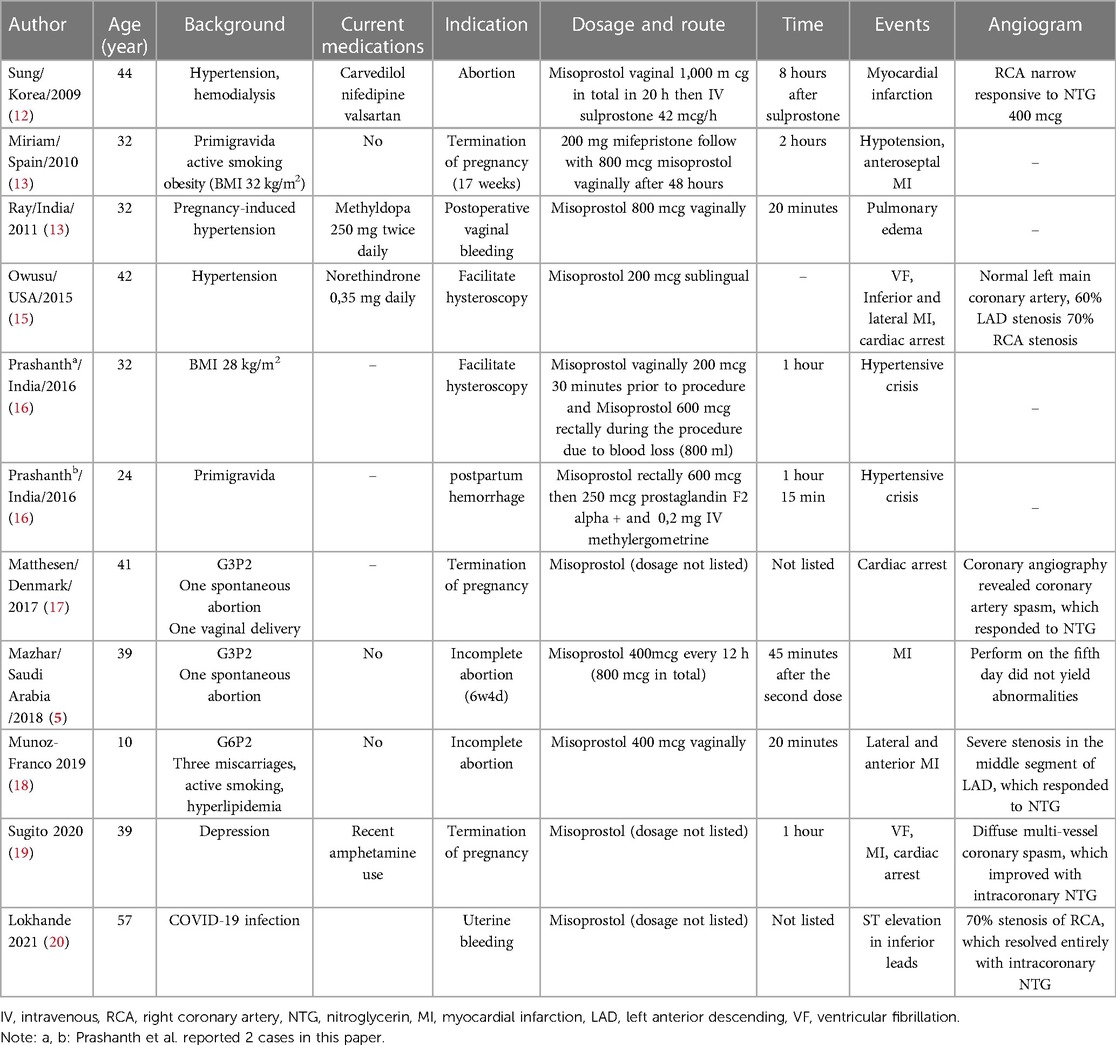- 1Emergency Department, University Medical Center, Ho Chi Minh City, Vietnam
- 2International Ph.D. Program in Medicine, College of Medicine, Taipei Medical University, Taipei, Taiwan
- 3AIBioMed Research Group, Taipei Medical University, Taipei, Taiwan
- 4Research Center for Artificial Intelligence in Medicine, Taipei Medical University, Taipei, Taiwan
- 5Pharmacy Department, University Medical Center, Ho Chi Minh City, Vietnam
- 6Department of Internal Medicine, Palmetto General Hospital, Hialeah, FL, United States
- 7Faculty of Medicine, Nam Can Tho University, Can Tho, Vietnam
- 8Professional Master Program in Artificial Intelligence in Medicine, College of Medicine, Taipei Medical University, Taipei, Taiwan
- 9Translational Imaging Research Center, Taipei Medical University Hospital, Taipei, Taiwan
Coronary artery vasospasm (CVS), an uncommon cause of acute chest pain, can be provoked by vasoconstriction-induced medications. Misoprostol, a prostaglandin analog, is a safe medication to terminate a pregnancy. However, misoprostol can cause coronary artery vasospasm due to vasoconstrictor properties, leading to acute myocardial infarction with nonobstructive coronary arteries (MINOCA), especially in patients with a high risk for cardiovascular disease. We report a case of a 42-year-old female with a past medical history of hypertension who presented with ST-elevation myocardial infarction following the administration of a high-dose Misoprostol. The fact that coronary angiogram and intravascular ultrasound revealed normal coronary arteries suggested transient coronary vasospasm. CVS is a severe but rare cardiac adverse effect associated with high-dose misoprostol. This medication should be prescribed with caution and close monitoring, especially in those with pre-existing heart disease or cardiovascular risk factors. Our case raises awareness of severe cardiovascular complications that can be related to using misoprostol in high-risk patients.
Background
Coronary arteries disease without significant flow-limiting lesions or severe coronary vasospasm can result in an acute imbalance between oxygen demand and supply, causing acute myocardial infarction with non-obstructive coronary disease (MINOCA) (1). In 2019, the American Heart Association's practical guidelines and algorithm were established to provide clinical guidance for the diagnosis and treatment of MINOCA (2). Misoprostol, a prostaglandin E1 analog, is currently used under the recommendation of the National Institute For Health and Care Excellence 2019 and the American College of Obstetricians and Gynecologists 2020 for the termination of pregnancy (3, 4). However, misoprostol uncommonly can induce acute coronary vasoconstriction when used with a high dose (5). Herein, we report a case of a 42-year-old female suffering from acute STEMI due to severe coronary vasospasm following the administration of high-dose misoprostol (400–1200 mcg within 24–48 h) for abortion induction.
Case presentation
A 42-year-old Vietnamese female (gravida 5 para 3) with a past medical history of hypertension reported taking Mifepristone 200 mg to induce the termination of her 5-week pregnancy one day before admission. The patient continued to take misoprostol 600 mcg sublingually one hour before hospitalization. She then experienced acute severe left-sided chest pain, dyspnea, and nausea prompted her to go to the hospital. Upon arrival, the patient noted bradycardia with a heart rate of 55 beats per minute and hypotension with a blood pressure of 70/40 mmHg. The other vital signs were stable, with a respiratory rate of 20 breaths per minute and saturation at 99% on room air. ECG showed 2 mm ST elevations in II, III, aVF, V1, V3R, and V4R with reciprocal depressions in I, aVL, and V6 (Figure 1). Laboratory findings were remarkable for markedly elevated hs-troponin T (103 ng/l). Since the presentation suggested acute ST-elevation myocardial infarction (Killip I) of the inferior and right ventricle, the patient was started on loading dual anti-platelet therapy and statin. Thirty minutes later, she reported that her chest pain had improved. Repeat ECG showed normal sinus rhythm with a heart rate of 70 beats per minute and complete resolution of ST-elevation. The subsequent coronary angiography revealed normal coronary without flow-limiting lesions (Figure 2). IVUS of RCA showed no evidence of significant stenotic lesions, thrombus, or dissections (Figure 3). Transthoracic echocardiography revealed a preserved ejection fraction of 68% without wall motion abnormalities or other structural heart diseases. Troponin level also decreased to 74 ng/L after 3 h of hospitalization and normalized after six days. The patient satisfied the criteria of MINOCA following the Fourth Universal Definition of Acute Myocardial Infarction with the elevated dynamic change of cardiac biomarker, ST elevation on ECG, and the result of coronary angiography without significant obstructing lesion (6). Due to the correspondence between the pharmacologic characteristics of Misoprostol and the clinical manifestation of patient, we assume the MINOCA is possibly caused by coronary vasospasm induced by misoprostol (6). She was eventually discharged with calcium channel blocker, beta-blocker, and statin. The patient remained asymptomatic and hemodynamically stable during her follow-ups in 30 days, 3 months, 6 months, and 12 months after discharge.

Figure 1. The upper ECG shows a 2 mm ST elevation (red arrow) at leads DII, DIII, aVF, V1, with reciprocal depression (blue arrow) in DI, aVL, and V6. This ECG suggests an inferior myocardial infarction with ST elevation. The lower ECG with right-side lead indicates a 2 mm ST elevation (red arrow) at lead V3R, and V4R which suggests a right ventricular myocardial infarction. RCA was suspected as culprit lesion.

Figure 2. Coronary angiography revealed patent coronaries including LCA (left) and RCA (right) without significant flow-limiting lesions.

Figure 3. Right coronary artery IVUS showed no significant stenotic lesion, no thrombus, and no dissection in proximal RCA (image 1 to 5), mid RCA (image 6 to 10), and distal RCA (image 11 to 20).
Discussion
About 6% of patient with acute myocardial infarction is diagnosed with nonobstructive coronary arteries by coronary angiography (7). Myocardial infarction with nonobstructive coronary arteries (MINOCA) is considerably confirmed when there is no evidence of other etiologies at the time of coronary angiography. A definite diagnosis usually requires extensive workup for various pathologies. Montone et al. reported 46% of patients with MINOCA responded to provocation testing, confirming coronary vasospasm (8). Coronary vasospasm is defined as an intense constriction of coronary arteries resulting in a significant imbalance between oxygen demand and supply. This phenomenon can provoke severe myocardial ischemia, acute myocardial infarction, or sudden cardiac death (1). The incidence of this disease varies significantly among races and between countries such as Japanese (24.3%), Taiwanese (19.3%) and Caucasian populations (7.5%) (9). Dr. Myron Prinzmetal first described this condition in 1959 and reported 32 cases of vasospastic angina (non-exertional chest pain) (1). The classic diagnostic criteria require a normal coronary angiography with spasm response to a provocative test (10). Various pathologic mechanisms were proposed, including the direct effect of catecholamines, inflammation, dysfunction of endothelial cells, smooth muscle cell hypercontractility, or increased oxidative stress (10). Compared to classic angina due to atherosclerotic artery disease, vasospastic angina induced by coronary vasospasm frequently happens in young female patients without significant cardiovascular risk factors (11). Moreover, typical precipitating factors for this condition include cold exposure, mental stress, stimulants, and medications, such as sympathomimetics and vasoconstrictor agents (10, 11). The cardiovascular events or adverse effects of misoprostol were summarized in Table 1 (5, 12–21).
Prostaglandin E (PGE) analogs have both vasoconstrictor and vasodilator properties (Supplementary Image S1). This medication has a long history of adverse cardiovascular effects. PGE2 analog, such as Sulprostone, has been reported to have severe cardiovascular complications such as acute myocardial infarction, cerebral ischemic stroke, and severe hypotension (18, 22, 23). Among the PGE1 analog, misoprostol in combination with mifepristone was approved by the European Medicines Agency for treating incomplete abortion and miscarriage, while Gemeprost was used with caution due to the risk of severe adverse cardiac events (5). The cornerstone mechanism of these complications was the various effect of Prostaglandin E receptors (EP), including EP 1, 2, 3 and 4. While EP 1 and EP 3 induce vasoconstrictors, EP 2 and EP 4 have substantial vasodilator properties. PGE2 analog stimulates all 4 four receptors, while the PGE1 analog activates only EP 2, 3 and 4 (18).
The selective activation of PGE1 explains these agents’ less frequent and severe cardiovascular complications. According to the prevailing hypothesis, it is widely believed that misoprostol exhibits a dose-dependent effect on the elevation of Norepinephrine (NE) levels. Consequently, the increased NE levels are thought to induce pronounced vasoconstriction and contribute to the occurrence of cardiovascular adverse events (24). In patients with medical history or high risk of cardiac disease, misoprostol was recommended to be used at a very low dose of 25 mcg every 4 h in combination with prior Mifepristone 200 mg to limit cardiovascular complications for induction labor (26).
Despite being commonly used in obstetrics and gynecology practice for labor induction and considered generally safe, misoprostol still carries a potential risk of cardiac adverse effects. In this particular patient, the Naranjo Score yields a score of 7 out of 13 points, suggesting a moderate likelihood of misoprostol being responsible for the observed cardiac adverse events (5, 22, 23). On the other hand, misoprostol at higher doses is typically used for terminating a pregnancy, yet evidence of its safety is still unclear. WHO recommends that a single dose of misoprostol 400 mcg should be given orally within 24–48 h after taking mifepristone to induce medical abortion for less than 7-week pregnancy. Additionally, besides the dose, the route of administration can impact the process of absorption, bioavailability, and the concentration of active compounds in the bloodstream (27). Misoprostol is usually administered by several pathways, including buccal, sublingual, vaginal, oral, or rectal. Among various routes, a sublingual pathway has the highest peak of plasma drug concentration while the vaginal with water has the most prolonged time of adequate drug concentration (25). So theoretically, the risk of adverse events is highest in these two administration pathways.
Thus far, there are no definitive criteria to diagnose Misoprostol-induced coronary spasm. In our case, the patient with risk factors for coronary artery disease exposed to Misoprostol 15–20 minutes before the onset of chest pain suggested a probability of association. Additionally, the plasma concentration of Misoprostol peaks at about 30 min and declines rapidly by 120 min if used orally (25). This pharmacokinetic can explain the resolution of chest pain and normalization of ST-T changes on ECG shortly after hospitalization. Moreover, the diagnosis is more consistent with coronary vasospasm when the following angiogram and IVUS exclude occluded coronary arteries. The dynamic changes of cardiac biomarkers, ECG and clinical symptoms of the patient suggest the diagnosis of MINOCA possibly due to coronary vasospasm induced by misoprostol. New imaging modalities such as optical coherence tomography and cardiac magnetic resonance (CMR) can be used to clarify the underlying pathologic mechanism. CMR plays a crucial role in the diagnostic evaluation of patients with MINOCA, as it is recommended for excluding non-ischemic cardiac causes including cardiomyopathies, myocarditis, pericarditis, and Takotsubo syndrome. CMR has been found to be useful in confirming the diagnosis in up to 74% of cases (6). However, further investigation of this case is challenging due to our limited facilities.
Conclusion
Myocardial infarction with nonobstructive coronary arteries due to acute coronary vasospasm is a severe condition precipitated by medications with vasoconstricting properties, such as misoprostol, as a PGE1 analog. Notwithstanding isolated case reports describing notable cardiovascular events linked to misoprostol administration, it is considered a safe and appropriate choice as the initial treatment option for medical abortion, aligning with the recommendations outlined in the current practice guidelines.
Our case proposes a precaution in using misoprostol in patients with a high risk for cardiovascular disease, who should be closely monitored for any emerging severe complications.
Data availability statement
The original contributions presented in the study are included in the article/Supplementary Material, further inquiries can be directed to the corresponding author.
Ethics statement
Ethical review and approval was not required for the study on human participants in accordance with the local legislation and institutional requirements. The patients/participants provided their written informed consent to participate in this study. Written informed consent was obtained from the individual(s) for the publication of any potentially identifiable images or data included in this article.
Author contributions
NVH and LTKH contributed to conception and design of the study. LTKH and LHNM organized the database. LHNM and TT wrote the first draft of the manuscript. LHNM and NQKL revised and approved the manuscript. All authors contributed to the article and approved the submitted version.
Conflict of interest
The authors declare that the research was conducted in the absence of any commercial or financial relationships that could be construed as a potential conflict of interest.
Publisher's note
All claims expressed in this article are solely those of the authors and do not necessarily represent those of their affiliated organizations, or those of the publisher, the editors and the reviewers. Any product that may be evaluated in this article, or claim that may be made by its manufacturer, is not guaranteed or endorsed by the publisher.
Supplementary material
The Supplementary Material for this article can be found online at: https://www.frontiersin.org/articles/10.3389/fcvm.2023.1115358/full#supplementary-material.
References
1. Prinzmetal M, Kennamer R, Merliss R, Wada T, Bor N. Angina pectoris I. A variant form of angina pectoris: preliminary report. Am J Med. (1959) 27(3):375–88. doi: 10.1016/0002-9343(59)90003-8
2. Tamis-Holland JE, Jneid H, Reynolds HR, Agewall S, Brilakis ES, Brown TM, et al. Contemporary diagnosis and management of patients with myocardial infarction in the absence of obstructive coronary artery disease: a scientific statement from the American heart association. Circulation. (2019) 139(18):e891–908. doi: 10.1161/CIR.0000000000000670
3. Creinin MD, Grossman DA. Medication abortion up to 70 days of gestation: aCOG practice bulletin, number 225. Obstet Gynecol. (2020) 136(4):e31–47. doi: 10.1097/AOG.0000000000004082
5. Mazhar F, Sultana J, Akram S. Misoprostol-induced acute coronary syndrome in a premenopausal woman: a case report with literature review. Curr Drug Saf. (2018) 13(1):65–8. doi: 10.2174/1574886312666171122100929
6. Thygesen K, Alpert JS, Jaffe AS, Chaitman BR, Bax JJ, Morrow DA, et al. Fourth universal definition of myocardial infarction (2018). Circulation. (2018) 138(20):e618–e51. doi: 10.1161/CIR.0000000000000617
7. Pasupathy S, Air T, Dreyer RP, Tavella R, Beltrame JF. Systematic review of patients presenting with suspected myocardial infarction and nonobstructive coronary arteries. Circulation. (2015) 131(10):861–70. doi: 10.1161/CIRCULATIONAHA.114.011201
8. Montone RA, Niccoli G, Fracassi F, Russo M, Gurgoglione F, Camma G, et al. Patients with acute myocardial infarction and non-obstructive coronary arteries: safety and prognostic relevance of invasive coronary provocative tests. Eur Heart J. (2018) 39(2):91–8. doi: 10.1093/eurheartj/ehx667
9. Pristipino C, Beltrame JF, Finocchiaro ML, Hattori R, Fujita M, Mongiardo R, et al. Major racial differences in coronary constrictor response between Japanese and caucasians with recent myocardial infarction. Circulation. (2000) 101(10):1102–8. doi: 10.1161/01.CIR.101.10.1102
10. Hung M-J, Hu P, Hung M-Y. Coronary artery spasm: review and update. Int J Med Sci. (2014) 11(11):1161. doi: 10.7150/ijms.9623
11. Slavich M, Patel RS. Coronary artery spasm: current knowledge and residual uncertainties. IJC Heart & Vasculature. (2016) 10:47–53. doi: 10.1016/j.ijcha.2016.01.003
12. Sung CW, Jung J-H, Lee S-H, Lee KM, Ahn BM, Choi S, et al. Acute myocardial infarction due to vasospasm induced by prostaglandin. Can J Cardiol. (2009) 25(10):e359–e60. doi: 10.1016/S0828-282X(09)70724-X
13. Illa M, Bennasar M, Eixarch E, Berge R, Font C, Palacio M. Acute coronary artery vasospasm associated with misoprostol for termination of pregnancy. Fetal Diagn Ther. (2010) 27(3):174–7. doi: 10.1159/000295923
14. Ray BR, Khanna P, Rewari V, Sinha R, Aravindan A, Trikha A. Misoprostol-induced pulmonary edema in a parturient with postpartum cardiomyopathy. J Obstetric Anaesthesia and Critical Care. (2011) 1(2):85. doi: 10.4103/2249-4472.93993
15. Owusu KA, Brennan JJ, Perelman A, Meoli E, Altshuler J. Nitroglycerin administration during cardiac arrest caused by coronary vasospasm secondary to misoprostol. J Cardiol Cases. (2015) 12(5):166–8. doi: 10.1016/j.jccase.2015.07.003
16. Prashanth A, Chakravarthy M, Maddirala P. Life threatening adverse reaction following prostaglandin analogue use in obstetric and gynecological practice. J Obstetric Anaesthesia and Critical Care. (2016) 6(1):34. doi: 10.4103/2249-4472.181077
17. Matthesen T, Olsen RH, Bosselmann HS, Lidegaard Ø. Cardiac arrest induced by vasospastic angina pectoris after vaginally administered misoprostol. Ugeskr Laeg. (2017) 179(26):V02170167. PMID: 28648167
18. Muñoz-Franco FM, Lacunza-Ruiz FJ, Vázquez-Andrés DJ, Rodríguez-Hernández JR. Coronary artery vasospasm after misoprostol treatment for incomplete abortion: a case report. Contraception. (2019) 100(6):498–501. doi: 10.1016/j.contraception.2019.08.003
19. Sugito S, Brooks C, Baker D, Brienesse S, Thambar S. 434 A case report of misoprostol associated coronary vasospasm and cardiac arrest. Heart. Lung and Circulation. (2020) 29:S233. doi: 10.1016/j.hlc.2020.09.441
20. Lokhande C, Shaikh K, Alugubelli N, Murray J. Acute coronary vasospasm after misoprostol treatment for dysfunctional uterine bleeding in a COVID-19 positive patient. J Am Coll Cardiol. (2021) 77(18_Supplement_1):2485. doi: 10.1016/S0735-1097(21)03840-7
21. Illa M, Bennasar M, Eixarch E, Berge R, Font C, Palacio M. Acute coronary artery vasospasm associated with misoprostol for termination of pregnancy. Fetal Diagn Ther. (2010) 27(3):174–7. doi: 10.1159/000295923
22. Johnson MR. Cardiac effects of drugs used for induction of labor and prevention and treatment of postpartum hemorrhage. In: Elkayam U, editor. Cardiac Problems in Pregnancy. (2019). p. 530–5. doi: 10.1002/9781119409861.ch36
23. Lee S, Cauldwell M, Wendler R. Cardiac effects of drugs used for induction of labour and prevention and treatment of postpartum haemorrhage. Int J Cardiol Congenital Heart Dis. (2021) 5:100208. doi: 10.1016/j.ijcchd.2021.100208
24. Yokotani K, Nishihara M, Murakami Y, Hasegawa T, Okuma Y, Osumi Y. Elevation of plasma noradrenaline levels in urethane-anaesthetized rats by activation of central prostanoid EP3 receptors. Br J Pharmacol. (1995) 115(4):672–6. doi: 10.1111/j.1476-5381.1995.tb14985.x
25. Tang O, Gemzell-Danielsson K, Ho P. Misoprostol: pharmacokinetic profiles, effects on the uterus and side-effects. Int J Gynaecol Obstet. (2007) 99:S160–S7. doi: 10.1016/j.ijgo.2007.09.004
26. Regitz-Zagrosek Vera, et al. 2018 ESC guidelines for the management of cardiovascular diseases during pregnancy: the task force for the management of cardiovascular diseases during pregnancy of the European Society of Cardiology (ESC). European heart journal. (2018) 39(34):3165–3241.30165544
Keywords: MINOCA, myocardial infarction in the absence of obstructive coronary artery disease, acute myocardial infarction, prostaglandin e1 analogue, coronary vasospasm.
Citation: Hau NV, Han LTK, Minh LHN, Kiet NA, Phong T, Duong NK, Yen PTH, Vinh NX, Hao NQN, Nguyen N, Truyen Thien Tan Tri Tai and Le NK (2023) A case report and literature review of myocardial infarction with nonobstructive coronary arteries (MINOCA) possibly due to acute coronary vasospasm induced by misoprostol. Front. Cardiovasc. Med. 10:1115358. doi: 10.3389/fcvm.2023.1115358
Received: 3 December 2022; Accepted: 21 April 2023;
Published: 26 May 2023.
Edited by:
Tommaso Gori, Johannes Gutenberg University Mainz, GermanyReviewed by:
Sivabaskari Pasupathy, University of Adelaide, AustraliaNaveen Anand Seecheran, The University of the West Indies St. Augustine, Trinidad and Tobago
© 2023 Hau, Han, Minh, Kiet, Phong, Duong, Yen, Vinh, Hao, Nguyen, Truyen and Le. This is an open-access article distributed under the terms of the Creative Commons Attribution License (CC BY). The use, distribution or reproduction in other forums is permitted, provided the original author(s) and the copyright owner(s) are credited and that the original publication in this journal is cited, in accordance with accepted academic practice. No use, distribution or reproduction is permitted which does not comply with these terms.
*Correspondence: Nguyen Quoc Khanh Le a2hhbmhsZWVAdG11LmVkdS50dw==
†These authors share first authorship
 Nguyen Viet Hau
Nguyen Viet Hau Luu Thi Kim Han
Luu Thi Kim Han Le Huu Nhat Minh
Le Huu Nhat Minh Nguyen Anh Kiet
Nguyen Anh Kiet Tang Tuan Phong
Tang Tuan Phong Nguyen Khanh Duong
Nguyen Khanh Duong Phan Thi Hoang Yen
Phan Thi Hoang Yen Nguyen Xuan Vinh
Nguyen Xuan Vinh Nguyen Quan Nhu Hao
Nguyen Quan Nhu Hao Nguyen Nguyen
Nguyen Nguyen Thien Tan Tri Tai Truyen
Thien Tan Tri Tai Truyen Nguyen Quoc Khanh Le
Nguyen Quoc Khanh Le